Immigration policy and demographic change in Scotland: learning from Australia, Canada and continental Europe
Report by the independent, Expert Advisory Group on Migration and Population situates Scotland's demographic circumstance in a wider context and looks at various international examples of immigration systems that have been designed to offset demographic challenges and other related shortages.
1. Scotland’s Demographic Challenge in Comparative Perspective
Industrialised countries have witnessed fundamental population changes over the past decades. Mortality has declined and life expectancy increased.[2] The post-WWII baby boom was followed by a fertility decline and long-term below replacement fertility.[3] Population ageing is shaping the economic and social life of industrialised countries, and these impacts will only increase in coming decades. At the same time, migration to and from industrialised countries has affected population size and structure over the past decades, with some countries having experienced immigration for decades, while others, including Southern European countries as well as Scotland, becoming countries of net in-migration more recently and receiving a significant number of immigrants in the first decade of this century.[4]
In this chapter, we provide a brief overview of the key changes in population size and structure of industrialised countries and the drivers of population change: fertility, mortality and migration. We compare population trends in Scotland with those in other OECD countries. These data set the scene for analysing immigration policy as a tool for addressing demographic challenges, as developed in subsequent chapters.
1.1 Population change
Similarly to many other industrialised countries, Scotland has experienced significant demographic changes over the past half a century. After decades of population decline due to out-migration of young adults, Scotland’s population declined to relatively low levels in the 1990s. Since then the country has enjoyed significant population growth. While there were 5.06 million people living in Scotland in 2000, the figure had increased to 5.44 million in 2018, an increase of 7%. Although this growth is unique in recent Scottish history, the trends in Scotland have not been exceptional in the wider context of industrialised countries. Indeed, in comparison with other OECD countries, Scotland’s population growth has been relatively modest. The population of most OECD countries including the UK has increased 10% to 20% over the past two to three decades. The population of North America (the United States and Canada) and Australasia has increased by as much as 30 to 45% (Figure 1.1).
Figure 1.1 Total population in the OECD countries, 1990-2018 (1990=100).
Source: United Nations World population prospects 2019 Annual population by age, National Records of Scotland population estimates.
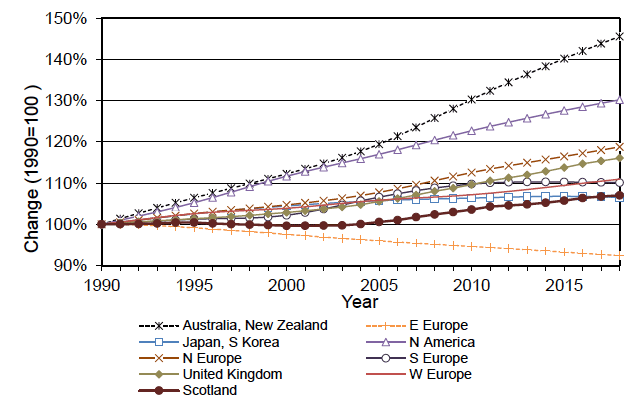
The only exception is Eastern Europe, whose population has declined over the past decades. The population growth in Scotland has also been modest if we compare it to that of a selection of European countries of the same size (Figure 1.2).
Figure 1.2 Total population in selected European countries, 1990-2018 (1990=100).
Source: United Nations World population prospects 2019 Annual population by age, National Records of Scotland population estimates. 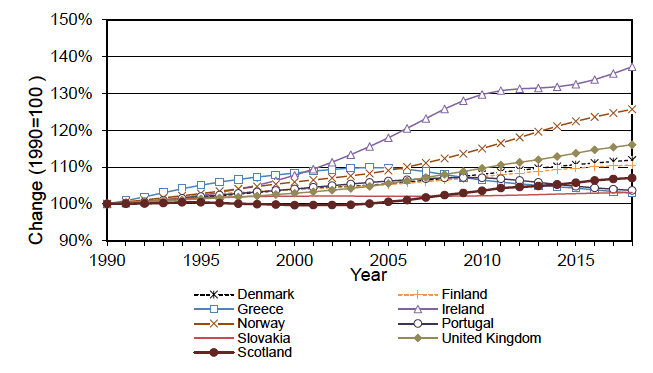
Most OECD countries have witnessed positive natural change (i.e. births have exceeded deaths). Natural population change was also positive in Scotland at the beginning of this decade, but has become negative in the last few years (Figure 1.3). This is strikingly similar to recent trends in Southern and Eastern European countries and the East Asian countries of Japan and South Korea, where the number of deaths has exceeded births in recent years.
Figure 1.3 Annual natural population growth rate (per 1,000 inhabitants), 1990-2018.
Source: United Nations World population prospects 2019 Annual demographic indicators, ONS Vital statistics in the UK: births, deaths and marriages.
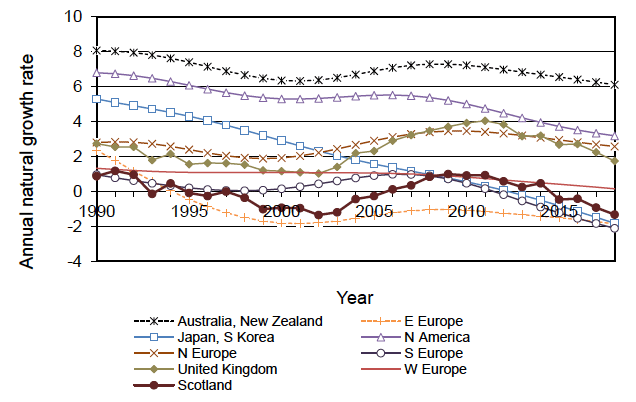
As expected, most OECD regions have enjoyed positive net migration in the past decades (Figure 1.4). Net migration has been the largest in Australia and New Zealand and the lowest in Southern and in East Asian countries. Eastern Europe is the only region that has lost population through migration. With four migrants per 1,000 population, Scotland holds a middle position similar to that of the UK and North American countries. Given that natural change has been negative in Scotland, increased migration both from the rest of the UK and from overseas has been the main driver of population growth in Scotland over the past two decades.
Figure 1.4 Annual net migration rate (per 1,000 inhabitants), 1990-2018.
Source: United Nations World Population Prospects 2019 Annual demographic indicators, National Records of Scotland Total migration to or from Scotland.
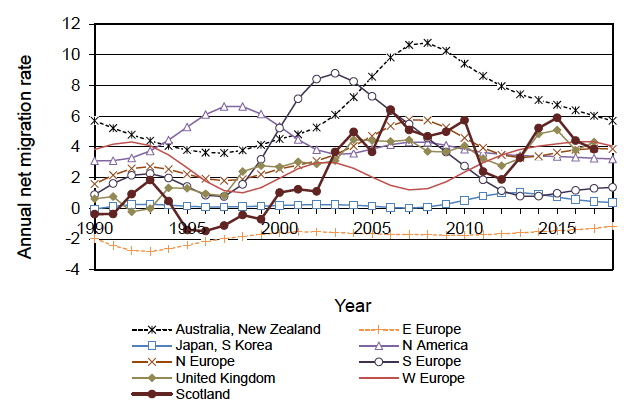
1.2 Mortality and fertility
Mortality has declined and life expectancy has gradually increased in all OECD countries. In 1990, most OECD countries had life expectancy at birth of around 75 to 77 years, whereas the figures were between 80 and 83 in 2018 (Figure 1.5). On average, life expectancy has risen about 2 years per decade. Much of the increase is attributed to the decline in cardiovascular mortality, and more recently increasing survival from cancers.[5] However, the ‘cardiovascular revolution’ has spread with different speeds across countries. While Western Europe witnessed a decline in cardiovascular mortality already in the 1960s, Eastern European countries had relatively high mortality from cardiovascular diseases until recently.[6] As a result, life expectancy in Eastern Europe has been more than 5 years lower than that in other OECD countries, and the region has enjoyed some increase only in the last decade or so. Mortality levels are also somewhat higher in Scotland than in other high-income countries; again, these are largely due to higher cardiovascular and cancer mortality. However, the life expectancy in Scotland approximates more closely to that of Western and Southern European countries than to Eastern Europe.
Figure 1.5 Life expectancy at birth, 1990-2018.
Source: United Nations World population prospects 2019 Annual demographic indicators, National Records of Scotland national life tables.
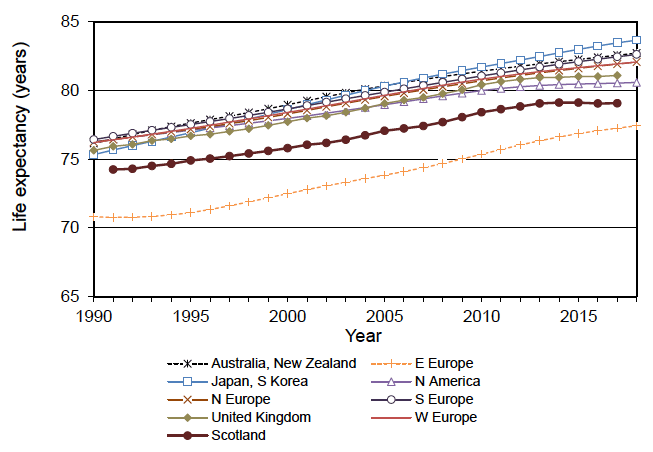
At the same time, there has been significant fluctuation in fertility levels. Fertility significantly increased in the first decade of this century, following a period of decline in the 1990s and low levels in most European countries at the turn of the century (Figure 1.6). Over the past decade, fertility has declined again in most OECD countries. The recent fertility decline has been more pronounced in Scotland than elsewhere, indeed Scotland has become one of the lowest fertility countries among high-income countries, along with East Asian (Japan and South Korea) and Southern European countries (e.g. Portugal, Greece and Spain). Changing fertility levels measured by the Total Fertility Rate (TFR) often reflect changing ages of childbearing (e.g. postponement of family formation), rather than the change in the average family size. Nevertheless, a decline in the TFR by 10% in the UK context will result in 40,000 fewer new-born babies annually. Long-standing debate on the causes of fertility decline and low fertility has emphasised the increased costs of childrearing or the spread of new (individualistic) ideas and cultural norms.[7] Recent research also emphasises the importance of welfare state policies and provisions and gender norms.[8] In Europe, fertility levels are relatively high in countries where policies support reconciliation of employment and parenthood and gender equality (as discussed further in Chapter 2). Interestingly, however, the recent fertility decline in many European countries suggests that economic factors may still be important drivers of fertility trends.
Figure 1.6 Total Fertility Rate, 1990-2018.
Source: United Nations World population prospects 2019 Annual demographic indicators, National Records of Scotland fertility rates by council area.
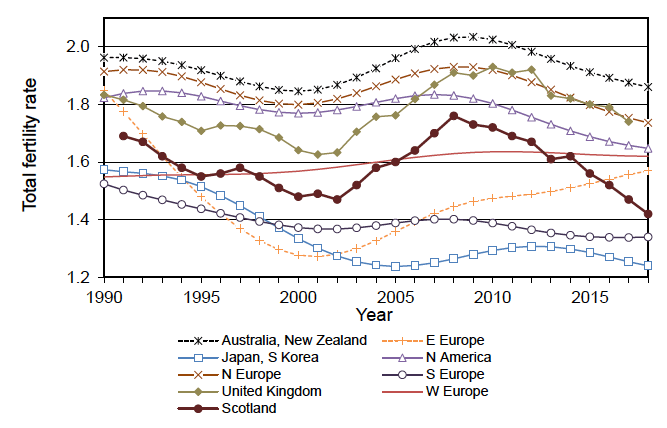
1.3 Age Structure of the Population
Past demographic processes of fertility, mortality and migration have shaped the current population structure of OECD countries. In all countries, the share of children (aged 0-14) has declined over the last decades. In most countries, children comprised around 20% of the population in 1990, whereas their share in some countries has declined more than 5 percentage points (Figure 1.7). The share of children is currently lowest in East Asian countries of Japan and South Korea, in Southern and Eastern Europe. This is largely attributed to relatively low fertility levels in these countries, which in some countries have persisted for decades.
Figure 1.7 Population aged 0-14 (percent), 1990-2018.
Source: United Nations World population prospects 2019 Annual population by age, National Records of Scotland population estimates.
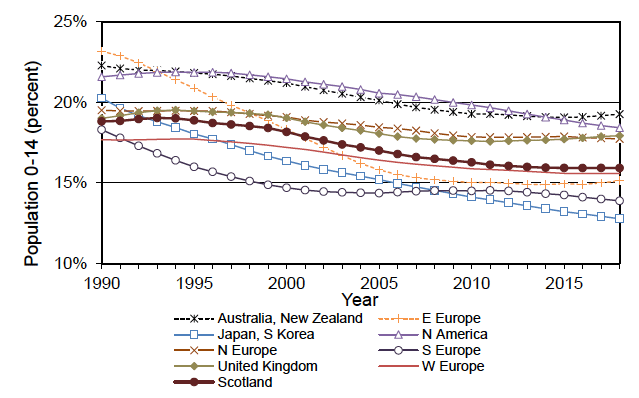
As expected, the share of population aged 65 and older has significantly increased in all OECD countries over the past three decades (Figure 1.8). However, there are striking differences in the percentage of the elderly population. While more than one-fifth of the East Asian and Southern European population is aged 65 or older, the figure is around 15% in North America, Australia and New Zealand. Scotland and the rest of the UK hold a middle position between these country groups.
Figure 1.8 Population aged 65+ (percent), 1990-2018.
Source: United Nations World population prospects 2019 Annual population by age, National Records of Scotland population estimates.
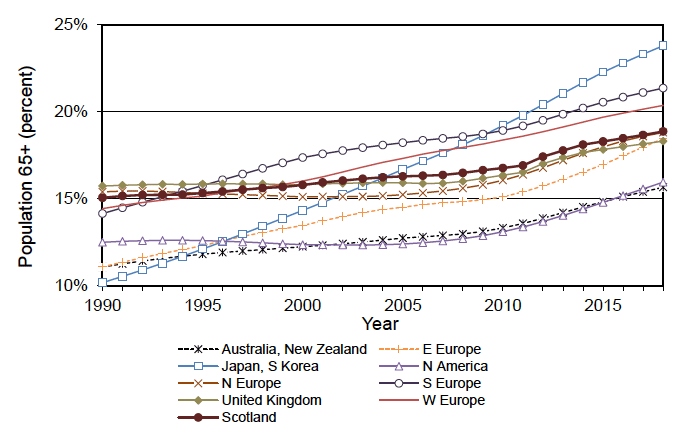
Overall, this shows that population ageing is pronounced in countries that have experienced long-term low fertility and little (if any) immigration. Changing population age structure is also reflected in the dynamics of the dependency ratio (the ratio of individuals aged 0-15 and 65+ to that of 16-64). The dependency ratio has slightly increased in the last decade (Figure 1.9); as expected, the increase has been pronounced for the old-age dependency ratio (the ratio of individuals aged 65+ to that of 16-64) (Figure 1.10).
Figure 1.9 Dependency ratio, 1990-2018.
Source: United Nations World population prospects 2019 Annual population by age, National Records of Scotland population estimates. 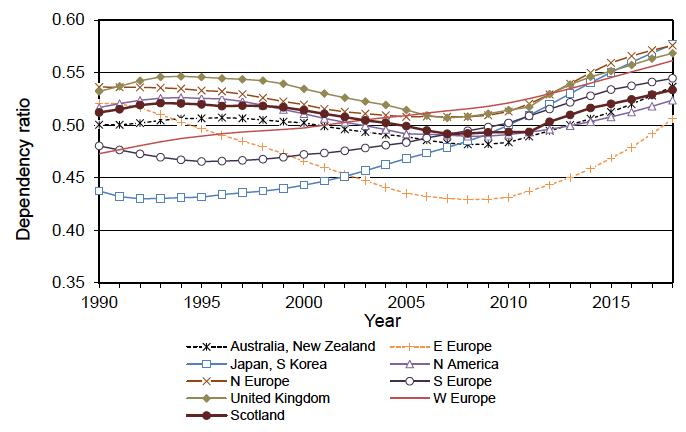
Figure 1.10 Old-age dependency ratio, 1990-2018.
Source: United Nations World population prospects 2019 Annual population by age, National Records of Scotland population estimates. 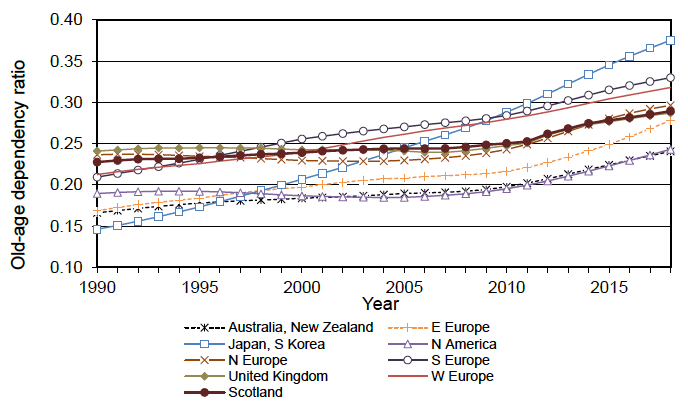
1.4 Regional population dynamics and structure
The analysis of population change in Europe at regional level provides further insights into demographic trends. Figure 1.11 supports the results of the country-level analysis showing population growth in most Western and Northern European countries and population decline in Eastern Europe. Further, within countries there are areas of growth, typically in large cities, and areas experiencing population decline. Scotland’s regions can be classified into two groups: the growing areas in the Central Belt and around the main cities, and the declining areas in the Northwest, Southwest and Western Islands.
Figure 1.11 Average annual population growth rate by NUTS 3 region (per 1000 inhabitants), 2013-2018.
Source: Eurostat 2019.
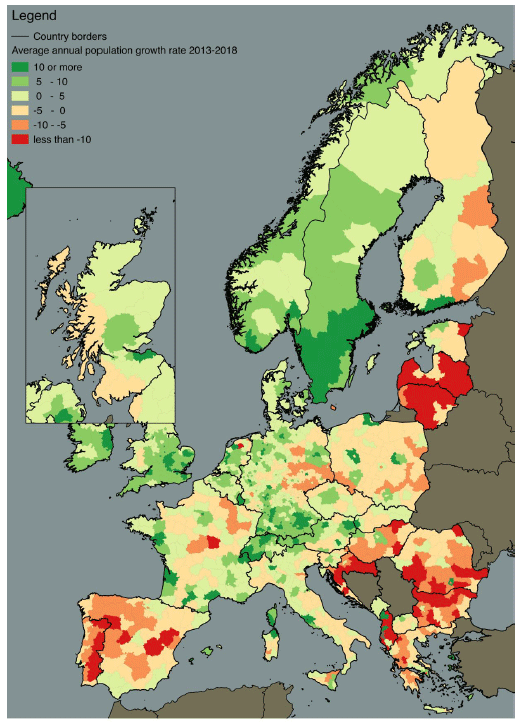
Significant differences also exist in migration levels. Most areas in Eastern Europe have experienced out-migration in the recent decade, except the areas around the capital cities (Figure 1.12). In contrast, most areas in Western and Northern Europe, including Scotland, have grown due to migration. The only exceptions are northern parts of France and Spain; the latter experienced large emigration flows in the first half of this decade.
Figure 1.12 Average annual net migration rate by NUTS 3 region (per 1,000 inhabitants), 2013-2017.
Source: Eurostat 2019.
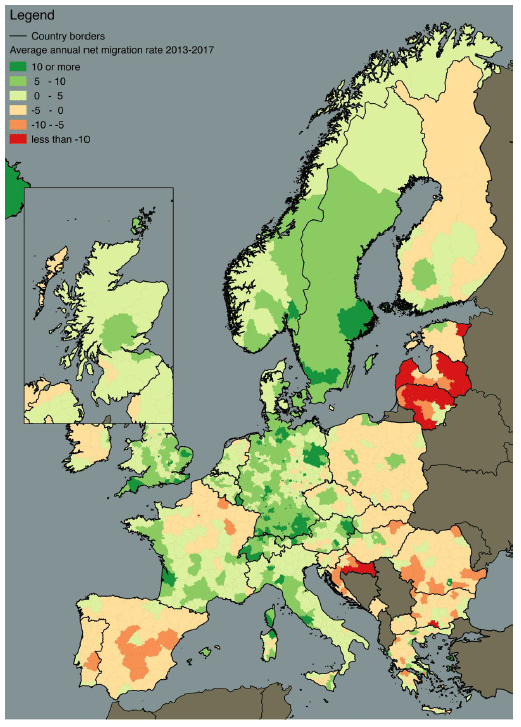
Distinct regional migration histories have also resulted in variations in the share of foreign-born population. As expected, the share of immigrants (or foreign-born population) is the largest in the main cities of the countries which were destination of the post-WWII migration streams (Figure 1.13). Although Southern European countries were for decades countries of emigration, recent immigration flows have led to the formation of immigrant communities, especially in the main cities, as well as in the coastal areas of Portugal, Spain and Greece. The share of immigrants is negligible in most Eastern European countries. The only exceptions are the Baltic States (Estonia, Latvia and Lithuania), which experienced significant labour migration streams from other parts of the former Soviet Union during the post-WWII period. In Scotland, immigrants mostly live in the larger cities and Eastern part of the country; their share is relatively low in Southern and Western Scotland.
Figure 1.13 Foreign-born population by NUTS 2 region and groups of Scotland council areas (percent), 2011.
Source: Eurostat 2019.
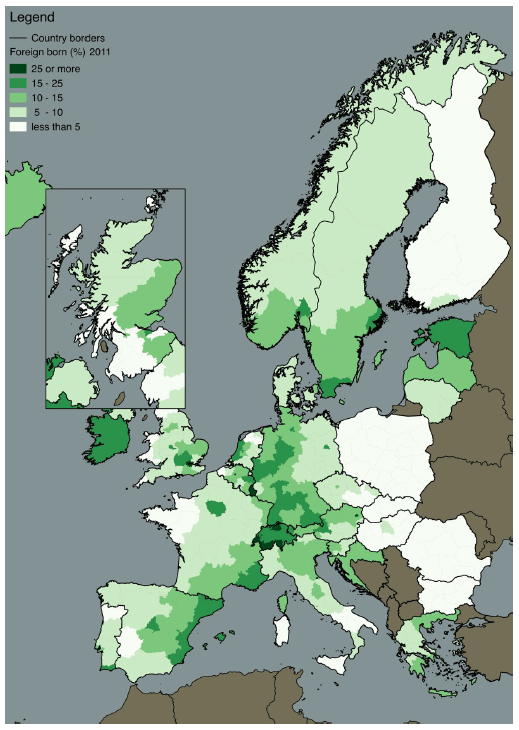
Finally, the share of elderly has grown across regions in Europe, although it is difficult to detect any consistent patterns (Figure 1.14). In Scotland, as expected, the share of people aged 65+ is largest in the Western and Southern parts of the country, which are dominated by rural areas, and lowest in the main urban centres.
Figure 1.14 Population aged 65+ by NUTS 3 region (percent), 2013-2017.
Source: Eurostat 2019.
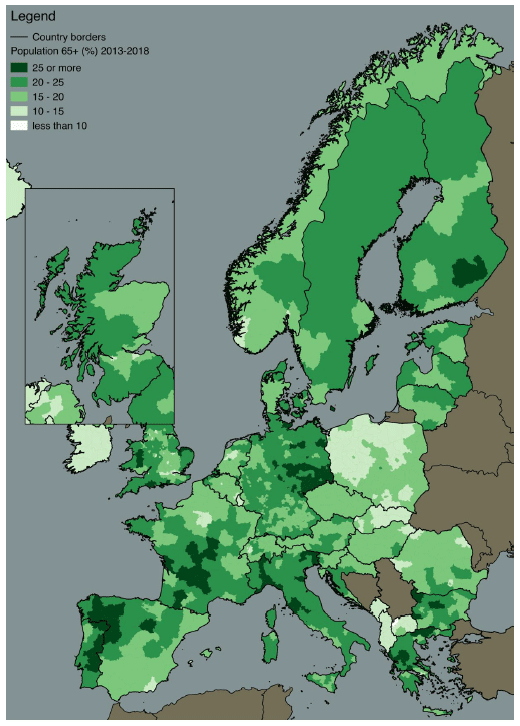
1.5 Challenges posed by demographic change
Population ageing affects all OECD countries, and will be a common trend in the coming decades. It is clear that no demographic process (neither increased fertility nor significant immigration) will be able to counterweigh the significant increase in the share of elderly residents in OECD countries in the near future. The reason for this is the large cohorts born in the first post-war decades who have also enjoyed increasing life expectancy. Hence, high-income societies need to adapt to ongoing demographic changes and reorganise economic and social life accordingly. However, there are significant differences across countries. Clearly, the challenges of population ageing will be pronounced in countries where rapidly increased longevity has been combined with low fertility and the lack of significant immigration (e.g. in East Asia). In Scotland, migration has helped reduce the speed of population ageing. However, if immigration to the country declines substantially, out-migration of young adults, which dominated a few decades ago, and declining fertility, may result in a decline of Scotland’s working age population in absolute as well as relative terms.[9]
These changes will have significant ramifications across Scotland’s economy and society. Higher dependency ratios will lead to a reduced tax base and aggregate labour shortages. Older populations will require expanded social security, health and social care, implying both a higher fiscal burden, and increased demand for goods and services in particular sectors. This will produce especially acute labour shortages in areas such as social and health care. An ageing workforce, and higher retirement ages, will also necessitate measures to enhance training and reskilling and foster innovation.
Regionally uneven population change represents an additional challenge. Many peripheral areas are experiencing population decline, most notably in Eastern Europe. In these rural and remote areas, population shrinkage combined with an increasing elderly population will pose significant challenges for the long-term economic sustainability and the provision of services in those areas. In Scotland, while in-migration to peripheral areas has been less significant than to large cities, such mobility has helped to stabilise and even rejuvenate the local population age structure in many areas.
Contact
Email: neil.meehan@gov.scot
There is a problem
Thanks for your feedback